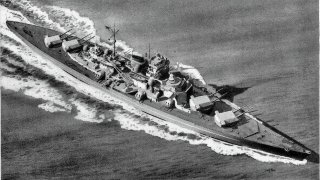Tirpitz: The Monster Bismarck-Class Battleship Marked for Death
The Tirpitz was massive – still, along with the namesake Bismarck battleship, the biggest European-made battleships ever constructed.
The Bismarck battleship is synonymous with disappointment and deflated expectations. The highly-touted Bismarck was scuttled within one year of being commissioned, after taking unsustainable battle damage. The Bismarck wasn’t just the name of a battleship, but rather a class of battleships, the Kriegsmarine’s Bismarck-class. There was another Bismarck: the Tirpitz. And while the Tirpitz is less well remembered than her first-in-class sibling the Bismarck, the Tirpitz met a similarly unremarkable fate, making the entire Bismarck-class amongst the most underperforming in modern naval history.
Building a Giant Battleship: Meet the Tirpitz
The Tirpitz was named for Grand Admiral Alfred von Tirpitz, the architect of the Kaiserliche Marine, or Imperial Navy. Laid down at the Kriegsmarinewerft in Wilhelmshaven, the Tirpitz was constructed over the course of thirty months, finally being launched in April of 1939 – a few months before the Nazis initiated their Blitzkrieg attack against Poland, the opening salvo of World War Two – and commissioned in 1941. Once commissioned, the Tirpitz was installed as the centerpiece of the Kriegsmarine’s Baltic Fleet, whose primary purpose was to prevent the Soviet’s Baltic Fleet from “breaking out.”
The Tirpitz was massive – still, along with the namesake Bismarck battleship, the biggest European-made battleships ever constructed. The impetus for the Bismack-class’s design was French naval expansion during the 1930s, most notably the building of two Richelieu-class battleships. Curiously, according to the international treaty in place at the time of construction, the Bismarck-class was illegal. The Anglo-German Naval Agreement, signed in 1935, prevented battleships from exceeding a 36,000-ton limit. The Nazi regime, however, secretly violated the treaty, building the Bismarck-class well beyond the parameters permitted in the Anglo-Saxon Naval Agreement.
Yet, by the time the Bismarck-class’s construction was complete, the Anglo-Saxon Naval Agreement had fallen apart. Japan withdrew in 1937, and resultingly, signatories were permitted to invoke “escalator clauses,” which allowed for the construction of battleships with displacements as high as 46,000 tons. The Tirpitz, when fully loaded, displaced 52,600 tons.
The finished Tirpitz measured 823 feet long, with a 118-foot beam and a maximum draft of 34 feet. For propulsion, the massive battleship relied upon three Brown, Boveri & Cie geared steam turbines, each of which drove a screw propeller with stem from twelve oil-fired Wagner superheated water-tube boilers. The propulsion system generated about 163,000 horsepower and 120,000 kilowatts of energy – good for a maximum speed of 30 knots.
The Tirpitz in Service
Once the Tirpitz was commissioned in 1941, Grand Admiral Erich Raeder deployed the new battleship to Norway to prevent a Soviet breakout, and to prevent convoys from reaching the Soviet Union. To act as a check against the Soviets, the Tirpitz was used as a “fleet in being” – which is a naval force that extends an influence without ever leaving port; after the loss of the Bismarck, Hitler was concerned with the loss of another battleship, and forbade an Atlantic sortie. Hitler permitted the Tirpitz’s use as a fleet in being, however.
The Tirpitz sailed to Trondheim, Norway, under escort from the Z4 Richard Beitzen, Z5 Paul Jakobi, Z8 Bruno Heinemann, and Z29. The voyage to Trondheim was codenamed Operation Polarnacht.
When the Tirpitz arrived in Trondheim, she was positioned next to the Faettenfjord and camouflaged with cut trees. The crew also made artificial fog to obscure the ship’s location from enemy bombers. Still, the Norwegian resistance movement transmitted the ship’s location to London. The Tirpitz, and her location, were fortified with anti-aircraft and anti-torpedo mechanisms. And the Tirpitz sat tight, so rarely deployed she earned the nickname “Lonely Queen of the North.”
The Nazi paranoia, the neurotic guarding of the Tirpitz, was well founded. Winston Churchill himself instructed that the Tirpitz’s destruction was “of utmost importance.”
Sinking the Tirpitz
The Tirpitz would persist, in its relatively monotonous, harbored existence, until 1944. The British had spent years eyeing the Tirpitz, and finally, with Operation Catechism, the Royal Air Force was able to sink the hallmark battleship.
When the Nazis moved Tirpitz to Tromso, Norway, the boat was in range of RAF bases in Scotland. The RAF attacked the Tirpitz, “again and again,” until November 12, 1944, when the fatal blow was dealt.
“Approaching the Norwegian coast individually in darkness, ‘wonderful navigation’ allowed ‘a swarm of four—engine gnats’ to congregate at the rendezvous lake and in a ‘gin-clear sky’ make for Tirpitz,” John Sweetman wrote. “The terrain around the anchorage near Tromso was too flat for an effective smoke-screen and the attackers evaded flak from the warship and shore batteries: only one damaged aircraft sought refuge in Sweden. Two direct hits and one near miss accounted for Tirpitz. Churchill’s beast had at last been slain.”

Afterwards, a British staff officer, looking at reconnaissance photos of the Tirpitz remarked “Sic transit gloria mundi,” Latin for ‘So passes away earthly glory.’
About the Author
Harrison Kass is a defense and national security writer with over 1,000 total pieces on issues involving global affairs. An attorney, pilot, guitarist, and minor pro hockey player, Harrison joined the US Air Force as a Pilot Trainee but was medically discharged. Harrison holds a BA from Lake Forest College, a JD from the University of Oregon, and an MA from New York University. Harrison listens to Dokken.
All images are Creative Commons.


